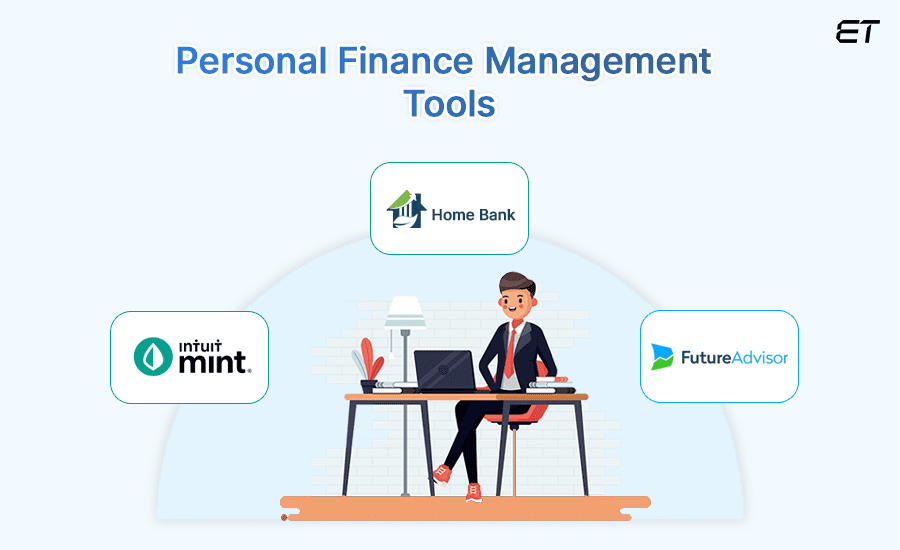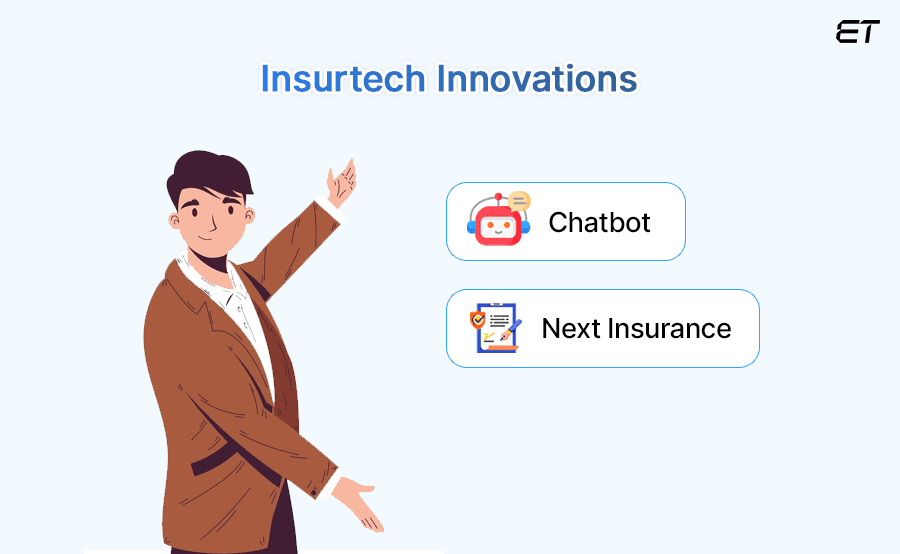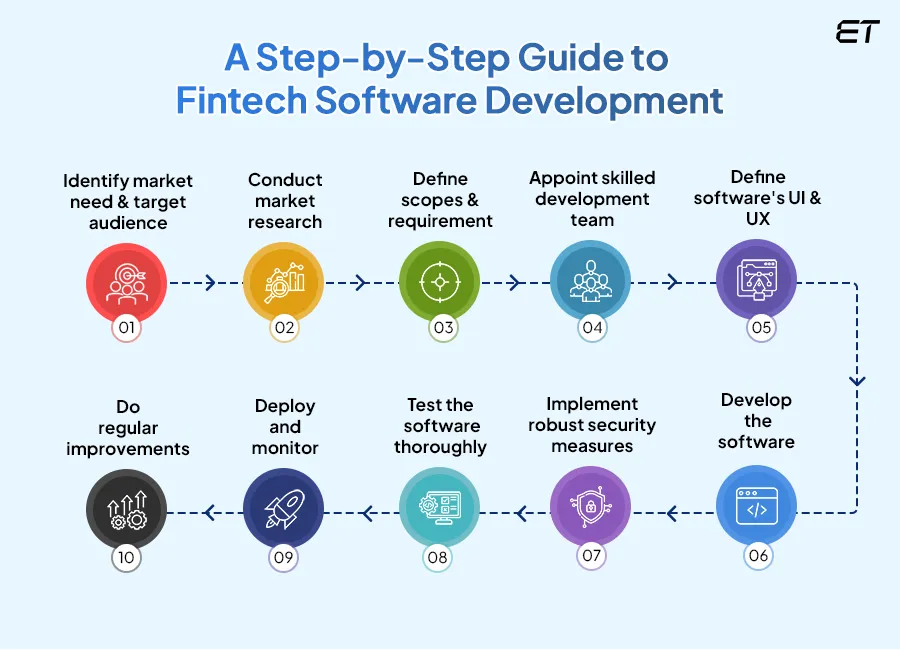
Your Guide to Fintech Software Development in 2025
Is your financial institution struggling to keep up with the fast-paced world of digital finance? Are outdated systems and clunky software holding you back from delivering seamless, cutting-edge services to your customers?
If so, it’s time for you to explore fintech. This is where your financial operations are efficient and innovative, where customer satisfaction is not an aspiration but a reality led by skilled fintech software developers who blend innovation with technology to reshape financial services, By integrating advanced technology into financial services, you can reshape your financial concerns, drive growth, and enhance your user experiences.
This guide will help you understand tech in finance and overcome your obstructions.
What is Fintech? How Does It Work?
Fintech (or financial technology) refers to the use of innovative digital solutions to enhance, automate, and streamline financial services. From mobile banking and online lending platforms to blockchain-based payment systems and robo-advisors, fintech is revolutionizing how you manage money.
Technically, fintech merges technology with financial services to make your transactions faster, smarter, and more accessible. It breaks traditional barriers by offering user-friendly fintech platforms that operate 24/7, often with lower fees and faster processing compared to conventional financial institutions.
So, how does fintech actually work?
Fintech solutions typically rely on a combination of cutting-edge technologies such as:
- APIs (Application Programming Interfaces) for seamless integration with third-party services like payment gateways or KYC platforms.
- Artificial Intelligence and Machine Learning to offer personalized financial insights, detect fraud, and automate decision-making.
- Blockchain and Cryptography for secure, decentralized transactions and digital currencies.
- Cloud Computing to provide scalable infrastructure and data storage without large upfront investments.
For example, when you use a mobile banking app to transfer funds, fintech is at work behind the scenes, verifying your identity, encrypting your data, and routing the payment through secure channels, all within seconds.
Whether it’s helping small businesses access microloans or enabling real-time investments with just a few clicks, fintech is transforming the financial ecosystem into one that’s faster, safer, and more customer-centric.
By aligning these key parameters with your business objectives, you can unlock greater value from your FinTech solution and deliver secure, intuitive, and scalable products that your users trust.
Why Fintech Matters?
Fintech app development is the integration of cutting-edge technology into your financial services, and a fintech software developer ensures the architecture supports efficiency, compliance, and scalability. From online banking and mobile payments to blockchain applications, fintech can drive innovation across all economic sectors. A report by Boston Consulting Group claimed fintech revenues are projected to grow from $245 billion in 2020 to $1.5 trillion by 2030, reflecting its immense potential and impact.
Let’s have a glance at the strategic importance that fintech offers financial institutions:
Enhancing Customer Experience
Customer experience is the most important factor in financial services. Therefore, fintech applications focus on personalization and user-centric design, providing tailored financial services that meet individual needs. For instance, For instance, AI-powered chatbots developed by experienced fintech developers can advise on financial matters, enhancing customer satisfaction and loyalty.
Operational Efficiency and Cost Reduction
Fintech automates various financial processes, reducing operational costs and increasing efficiency. For example, robotic process automation (RPA) streamlines tasks like loan underwriting and claims processing, allowing financial institutions to operate more efficiently.
What is Financial Software Development?
Financial software development is the process of creating digital solutions tailored to streamline, manage, and enhance financial services. It involves building applications and platforms that cater to various needs within the financial sector, from payment processing and online banking to asset management, insurance, and compliance solutions. Financial software development focuses on harnessing technology to improve efficiency, ensure secure transactions, and offer a seamless user experience for customers and businesses alike.
At its core, financial software development is about addressing the unique challenges of the finance industry, such as managing large volumes of data, ensuring compliance with regulatory standards, and maintaining top-tier security. These solutions are often developed by expert fintech software developers who understand the complexities of regulations, security, and financial workflows.
Key Aspects of FinTech Software Development
We already know by now what fintech app development is and why it matters. However, to build a robust and future-ready fintech platform for your business, it’s crucial to understand the core components that drive innovation and success.
Below is a breakdown of the essential aspects that shape successful fintech app development:
| Parameters | Details |
| Focus | Security, scalability, compliance, and seamless user experience are the areas where an experienced fintech software developer plays a vital role. |
| Technology | Cloud computing, blockchain, AI/ML, APIs, and mobile-first frameworks like React Native, Flutter, and Node.js are the key tools in any fintech developer’s toolkit. |
| Applications | Mobile banking apps, digital wallets, robo-advisors, loan management systems, payment gateways, and insurtech platforms are all core applications of a powerful fintech platform. |
| Goals | Streamline financial services, boost accessibility, personalize user experiences, and ensure regulatory compliance through skilled fintech software developers. |
| Benefits | Faster transactions, reduced operational costs, improved customer engagement, real-time analytics, and enhanced transparency. |
| Examples | Revolut (neobank), Stripe (payments infrastructure), Robinhood (investment app), and Plaid (financial data APIs) are all powered by advanced fintech platforms. |
By aligning these key parameters with your business objectives, you can unlock greater value from your FinTech solution and deliver secure, intuitive, and scalable products that your users trust.
Types of Fintech Software Development
As you know, different types of fintech platforms address unique financial needs, from payments and lending to investment and insurance, each requiring the expertise of a fintech developer. Let’s look at the fundamentals that make fintech applications effective and powerful.
1. Payment Processing Solutions

Payment processing is the heart of fintech, enabling secure and efficient transactions between businesses and customers. These solutions handle the authorization, funding, and settlement of transactions, ensuring that the payments are processed quickly and securely. They support various payment methods, such as credit cards, debit cards, digital wallets, and bank transfers. One popular example that you use in your daily life is PayPal.
To understand this better, below are the features of the advanced payment processing solutions:
- Ensures that transactions are completed in real time, enhancing customer satisfaction.
- Leverages machine learning algorithms to identify and prevent fraudulent transactions.
- Allows businesses to accept payments in multiple currencies, making international trade possible and feasible.
- Easily integrates with existing financial systems and e-commerce platforms, providing a seamless payment experience.
2. Blockchain and Cryptocurrency Applications

Blockchain technology provides you with a decentralized and secure way to record transactions, ensuring transparency and reducing the risk of fraud. Cryptocurrencies like Bitcoin and Ethereum are digital assets that use blockchain technology to enable peer-to-peer transactions without the need for intermediaries.
Key features of blockchain and cryptocurrency applications are:
- It eliminates the need for a central authority, reducing the risk of manipulation and fraud.
- All transaction details are publicly accessible, which makes it transparent. This increases trust and accountability among customers.
- Cryptographic techniques ensure the integrity and confidentiality of transactions, strengthening its security.
- Automated contracts execute when predefined conditions are met, enhancing efficiency and reducing the need for intermediaries or human interference.
3. Personal Finance Management (PFM) Tools

PFM tools help individuals manage their finances by tracking income, expenses, and investments. These tools provide comprehensive insights into your spending habits, offer budgeting advice, and help you make informed financial decisions. One such example of a PFM tool is Mint.
Below are the features of PFM tools:
- Monitors and categorizes expenses, helping you understand your spending habits.
- Allows you to set and track budgets for different spending categories.
- Helps you set and achieve your financial goals, such as saving for a vacation or paying off debt.
- Send reminders for your bill payments, low balances, and unusual transactions.
4. Insurtech Innovations

Insurtech refers to the use of technology to enhance the insurance industry. This includes digital platforms for claims processing, AI-driven risk assessment, and personalized insurance products. From underwriting to claims management, these innovations streamline the insurance process. It aims to make insurance more accessible, affordable, and user-friendly. One of the best examples of Insurtech is Lemonade.
Features of Insurtech include:
- It uses artificial intelligence to assess risk more accurately and personalize insurance products accordingly.
- Simplifies the claims process, allowing you to submit and track claims online.
- Adjusts premiums based on real-time data, such as driving behavior or health metrics.
- Enhances interaction with policyholders through mobile apps and online portals.
5. Lending and Crowdfunding Platforms

Lending and crowdfunding platforms eliminate traditional banking interference by connecting borrowers with lenders and investors, facilitating loans without any intermediaries. These types of fintech platforms democratize access to credit, allowing fintech software developers to build systems that reduce your reliance on traditional financial gatekeepers. For example, LendingClub.
Features of lending and crowdfunding platforms include:
- It allows individuals to lend money to individuals (peer-to-peer) or businesses, bypassing traditional banks.
- Uses an algorithm to assess the credit score of borrowers quickly and accurately.
- Provides clear terms and conditions, reducing uncertainty for borrowers and lenders.
- Enables individuals and businesses to raise funds from many people (community), typically through online campaigns.

Explore Top Custom Software Development Companies for 2025.
Top 5 Fintech Software Examples
Fintech has branched out into various sectors, reshaping how we borrow, invest, insure, and transact. Let’s take a look at five standout fintech software examples that showcase the diversity and impact of financial technology.
1. PayPal
PayPal is one of the pioneers of digital payment solutions. It allows you to send and receive money securely across borders without the need for traditional banking channels. With features like one-click checkout and fraud protection, PayPal simplifies your e-commerce transactions as well.
2. Robinhood
Robinhood disrupted the traditional brokerage model by offering commission-free stock trading through an intuitive mobile app. It uses real-time market data and a sleek interface to make investing accessible even if you’re a beginner. Robinhood has led to the rise of DIY investing.
3. Stripe
Stripe is a developer-friendly platform that powers online transactions for companies of all sizes. It offers APIs for integrating payments, billing, fraud detection, and more. Stripe’s offerings makes it a go-to choice for tech-savvy startups and established enterprises alike.
4. Chime
Chime is a digital-only bank that offers you services like fee-free overdrafts, early direct deposits, and automated savings. Without any physical branches, Chime relies entirely on mobile technology to provide you convenient and cost-effective banking experiences.
5. Lemonade
Lemonade reimagines the insurance experience using AI and data-driven models. From renters and homeowners insurance to pet coverage, it provides insurance for all. The platform processes claims quickly and transparently (often within minutes) making it a favorite among digital-first users.
A Step-by-Step Process to Fintech Software Development
Coming to the important part, let’s understand how fintech software development works. Below is a walkthrough of essential steps to developing a robust fintech application that meets modern market needs.

Step 1 – Identifying market needs and your target audience
Before you start with the development, it’s crucial to understand the specific needs of your target market. This involves thorough market research and competitive analysis. Ask yourself following questions:
- What financial problems are you aiming to solve?
- Who are your target customers?
- What are your competitors offering, and where are the gaps they cannot bridge?
By identifying a clear niche, such as payment processing, personal finance management, or blockchain solutions, you can tailor your fintech application to address the specific pain points of your target audience and stand out from the competition.
Step 2 – Conducting market research
Understanding your market requirements and preferences is essential for developing a successful fintech product that satisfies your customers and bridges the market gap. You can conduct surveys, focus groups, and interviews with potential customers to gather insights into their needs.
Also, analyze existing products to see what works and what doesn’t. This will give you a clear picture and save you time and resources. Moreover, it will help refine your value proposition and ensure your product resonates with the target audience.
Step 3 – Defining scopes and requirements for your software
Once you have a clear understanding of the market, define the scope and requirements of your fintech software. Below are the different scopes and requirements you need to determine:
Features and functionality: List your application’s core features. Prepare a framework of the functionalities and prioritize them based on user needs and technical feasibility.
Technology stack: Choose the right technology stack to support the scalability, security, and performance of your fintech software application. Common choices include Java, Python, and blockchain technologies.
Regulatory compliance: Ensure your software complies with relevant financial regulations and standards, like GDPR, AML, and KYC. This is one of the most important factors that you should keep in mind for successful and smooth operations.
Step 4 – Appointing/Hiring a skilled development team
The development team is the backbone of your project. Therefore, hire a team that includes at least one experienced fintech developer, as their domain knowledge is crucial for regulatory compliance and secure architecture. Choosing the right development team is directly proportional to the success of your software. The development team must include:
Project managers: PMs are the ones who oversee the entire project and ensure that it stays on track and meets deadlines.
Developers: They build the software, focusing on front-end and back-end development.
Designers: The designer’s role in software development is to work on the software’s UI/UX to make it creative, intuitive, and user-friendly.
QA testers: They ensure that the software is bug-free and performs well under various conditions.
Security experts: They handle the security aspects of your software. They specialize in implementing robust security measures to protect sensitive financial data.
Step 5 – Designing the user interface (UI) and user experience (UX) of the software
A seamless, simple, intuitive user experience is crucial for fintech applications, especially as the target audience varies. Work with your design team to create wireframes and prototypes that showcase the user journey and are easy to navigate. Focus on the following aspects:
Simplicity: Ensure the interface is easy to navigate, even for users with limited technical knowledge.
Consistency: Maintain a consistent design language across all screens, categories, and features.
Accessibility: When designing your software’s UI/UX, consider all types of users with limited knowledge or disabilities.

Want to know about the best practices you should follow for software development? Read out Software development best practices to learn more!
Step 6 – Developing the software
Once the scope, requirements, and design layouts are decided and set in place, it’s time to start the development. You can use agile methodologies to manage the development process as they allow for iterative progress and regular feedback at every step.
Three main aspects that you need to keep in the initial development process are:
Front-end development: Build the application’s user interface, ensuring that it’s responsive and visually appealing, and provide a user experience that makes navigating the application easy and smooth.
Back-end development: Develop the server-side logic, databases, data storage, and APIs that power the application.
Integration: Integrate third-party services like payment gateways and financial data providers.
Step 7 – Implementing robust security measures
Security in fintech software goes a long way without having to mention this. It’s a mandatory requirement and a seasoned fintech software developer knows that building secure applications involves more than just encrypting data. Therefore, implementing advanced security features to protect user data and transactions is crucial.
Below are the three aspects through which you can make your security system strong:
Encryption: Encrypting all sensitive data both in transit and at rest boosts its security, making it strong enough to decrypt and prevent data leaks or hijacking, for that matter.
Multi-factor authentication (MFA): MFA enhances security by requiring multiple forms of verification. It increases the security shield against hackers trying to breach your data.
Regular audits: In addition to putting up security shields, regular security audits and penetration testing are also necessary to identify and address vulnerabilities beforehand.
Step 8 – Testing the software thoroughly
After your fintech software is developed, it’s time to test it. Testing ensures that your software is reliable and performs well under various conditions. There are different types of testing for multiple conditions. Let’s discuss it below:
Unit testing: This involves testing individual components to ensure they function correctly.
Integration testing: This verifies that different components work together seamlessly without any obstruction.
User acceptance testing (UAT): As the name suggests, this method uses feedback from actual users to identify usability issues and then fix them.
Performance testing: This ensures the application can handle high loads without degrading the performance of the software.
Step 9 – Deploying and monitoring of the fintech software
Once your software passes all the tests, it’s ready for deployment. Choose a reliable hosting solution that offers scalability and robust security features. After the software is deployed, all you have to do is monitor it.
Monitor performance: Monitor the performance of the software continuously to detect and resolve issues quickly.
Gather feedback: Collect user feedback to identify the areas for improvement in your application.
Regular updates: Keep the software up-to-date with new features, security patches, and performance enhancements.
Step 10 – Be ready for continuous and regular improvements
Fintech software development doesn’t just end with deployment. Continuous improvement is mandatory to keep your application competitive and aligned with user needs. Therefore, regularly update your software with new features, enhancements, and security updates based on user feedback and market trends.

Did you know there’s a difference between end to end testing and integration testing?
How Much Does Fintech Software Development Cost?
One of the most frequently asked questions when starting a fintech project is: How much will it cost to build? While there’s no one-size-fits-all answer, understanding the key cost factors can help you plan your budget more effectively.
Fintech software development company’s cost typically ranges between $50,000 and $500,000+, depending on the complexity, features, and type of application you’re building. For instance, a simple mobile payment app may cost significantly less than a fully integrated robo-advisory platform or AI-driven trading software.
Here are a few critical factors that influence the overall cost:
- Scope and Complexity: The more features you want, like real-time analytics, third-party integrations, biometric authentication, or AI capabilities, the higher the development cost.
- Tech Stack: Choosing the right programming languages, frameworks, and databases directly impacts the development timeline and associated expenses.
- UI/UX Design: A well-crafted, user-friendly interface is essential in fintech. Investing in intuitive and secure design may slightly increase initial costs but offers long-term ROI.
- Compliance and Security: Fintech apps must adhere to strict regulations such as PCI-DSS, GDPR, or AML guidelines. Building with compliance in mind adds to the development hours and costs.
- Development Team Location: Hiring developers in North America or Western Europe is generally more expensive compared to partnering with a reliable offshore team in regions like Eastern Europe or South Asia.
It’s worth noting that cutting corners on fintech software development services costs development costs can backfire, especially in fintech, where performance, reliability, and trust are non-negotiable. A well-planned MVP (Minimum Viable Product) can be a smart way to launch quickly and scale efficiently without compromising on quality or compliance.
Pros and Cons of Fintech Software Development
Now that we have discussed fintech and the step-by-step process of developing software, it’s also necessary to learn about its pros and cons.
Fintech software development has transformed the financial industry, offering numerous benefits while also posing some challenges. Below, we have discussed the pros and cons of fintech software development.
| Pros | Cons |
| Increased efficiency and automation | Expensive and time-consuming licenses |
| Improved customer experience | Prime target for cyberattacks |
| Cost efficient compared to traditional banking | Technical complexity in integrating with existing systems |
| Advanced and increased security | High market competition |
| Equal financial benefit for all | Have to gain trust and ensure service quality constantly |
| Innovation and flexibility | Significant initial upfront investment |
Pros of Fintech Software Development
- Increased efficiency and automation: Automation reduces the need for manual intervention, and speeds up your financial transactions and processes. Transactions are processed quickly, improving overall efficiency and user satisfaction.
- Improved customer experience: Fintech applications can offer you tailored financial advice and services based on user data. Your users can access financial services anytime from anywhere, increasing convenience and satisfaction.
- Cost reduction: Technologies like blockchain reduce transaction fees compared to traditional banking systems.
- Enhanced security: Implementing encryption and other security shields protects your user data. AI and machine learning algorithms make it complex for hackers to breach it and identify fraudulent activities in real-time.
- Equal financial benefit: Fintech solutions provide equal financial benefit to everyone, be it rural areas or underserved areas where traditional banking cannot reach.
- Innovation and flexibility: Fintech companies quickly adapt to market changes and customer needs, fostering continuous innovation and flexibility.
Cons of Fintech Software Development
- Regulatory challenges: Obtaining necessary licenses can be expensive and time-consuming.
- Security risks: Despite advanced security measures, fintech applications are prime targets for cyberattacks. Ensuring the privacy and protection of your user data is a constant challenge.
- Technical complexity: Integrating new fintech solutions with existing systems and keeping software up-to-date with the latest advancements can be challenging and resource-intensive.
- Market competition: Staying updated with the ever-evolving market trends can be challenging.
- Customer trust: It can take time and effort to gain the trust of customers accustomed to traditional banking methods and ensure consistent service quality and reliability.
- Initial investment: Developing a comprehensive fintech solution requires significant upfront investment in technology and talent.
Technology Stack for Fintech Software Development
Choosing the right stack ensures your fintech platform performs efficiently while remaining secure and scalable, qualities that a professional fintech developer prioritizes. Fintech solutions need a robust foundation to handle vast data volumes, ensure security, and deliver a seamless user experience.
Here’s a quick look at the essential components of a fintech tech stack:
- Backend Technologies: For backend development, languages like Java, Python, and Ruby are popular due to their security and flexibility. Node.js is also favored for its speed and real-time data handling.
- Frontend Technologies: A user-friendly interface is vital in fintech apps. Frameworks like React, Angular, and Vue.js are commonly used for creating responsive and engaging UIs.
- Databases: Secure and scalable databases are essential. PostgreSQL, MySQL, and MongoDB are popular choices for relational and NoSQL database needs. Redis is also used for caching to improve app performance.
- Cloud Computing: Cloud platforms like AWS, Google Cloud, and Microsoft Azure offer scalability and security, enabling fintech companies to scale on demand and securely manage data.
- Blockchain & Cryptography: For apps dealing with cryptocurrency and secure transactions, blockchain frameworks like Ethereum or Hyperledger, along with strong cryptographic tools, are essential for secure, transparent processes.
- Artificial Intelligence (AI) & Machine Learning Tools: TensorFlow and PyTorch are popular for integrating AI functionalities like fraud detection, risk analysis, and personalized user experiences.
- Payment Gateways: Integration with payment gateways such as PayPal, and Square allows you smooth and secure transactions within fintech applications.
The Future of Fintech Development: Market Overview and Trends
The fintech software industry is growing at a staggering pace, reshaping how financial services are delivered and consumed. Driven by advances in technology and changing customer expectations, the global fintech market is projected to keep expanding. By 2028, the Digital Payments market is estimated to have 4,805.00 million users.
Let’s glance at the latest trends in fintech software development below:
- Increased adoption of contactless digital payment solutions as consumers today seek faster, more convenient methods of payment.
- Interest in decentralized finance (DeFi) and blockchain is growing for secure, transparent, and efficient financial transactions.
- Enhanced fraud detection, predictive analytics, and personalized customer experiences powered by AI and machine learning technologies.
- Collaboration between banks and third-party providers to offer customers greater financial transparency and improved services.
- Seamless integration of financial services into non-financial apps, enabling companies to offer banking-like features directly in their platforms.
- Development of regulatory technology (RegTech) tools to help financial institutions stay compliant with evolving regulations efficiently.
- Emphasis on advanced security solutions to protect sensitive financial data amidst growing cyber threats.
eLuminous Technologies: Your Trusted Fintech Software Development Company
eLuminous Technologies is a fintech software development company. We provide you with custom fintech solutions that align with your business goals and user expectations. Whether you’re launching a startup or upgrading enterprise-level fintech platforms, our team of fintech software developers delivers tailored, secure, scalable, and high-performing fintech applications.
Here’s what sets us apart:
- End-to-End Development: We handle the complete fintech software development lifecycle from ideation to deployment and support.
- Security-First Approach: We strictly comply with industry standards like PCI-DSS, GDPR, and KYC/AML.
- Custom-Built Solutions: We tailor every application to meet your unique business needs and regulatory environment.
- Agile Development: Team ET ensures rapid iterations, faster go-to-market, and continuous improvement using agile methodologies.
- Global Delivery Model: Our hybrid engagement model offers cost-effective development without compromising quality.
To Wrap Up!
Fintech software development is not just a trend but a crucial requirement for financial institutions today. The benefits of fintech are substantial. However, the journey is not without its challenges. Fintech is an invaluable asset for your business’s financial growth and innovation.
Whether you’re launching a new fintech venture or upgrading your existing system, the correct implementation of these technologies can transform your business operations and services. By partnering with experienced software development company, you can harness the full potential of these innovations and benefit your business.

Looking forward to your own fintech software development? Connect with Software Development Team and schedule your meeting today!
Frequently Asked Questions
1. What are the main benefits of fintech software development for financial institutions?
Fintech software development enhances efficiency through automation, reduces operational costs, and improves customer experience with personalized and accessible financial services. It also offers increased security through advanced encryption and fraud detection technologies.
2. What challenges do companies face in fintech software development?
Companies often encounter regulatory challenges, cybersecurity risks, and technical complexities when integrating new fintech solutions with existing systems. Additionally, maintaining customer trust and ensuring consistent service quality can be difficult.
3. How does fintech software improve customer experience?
Fintech software provides personalized financial services, allowing users to access banking and financial products anytime, anywhere. Features like real-time transactions and user-friendly interfaces enhance convenience and satisfaction.
4. What technologies are essential for successful fintech software development?
Key technologies include blockchain for secure transactions, AI and machine learning for fraud detection and personalized services, and cloud computing for scalability and cost efficiency. Integration with APIs and open banking frameworks is also crucial.
5. Do you provide fintech software development services?
Yes, we do provide different development services, fintech software development is one of them.
6. How to Hire a Finance Software Development Company?
If you are looking to hire a finance software development company, you can:
Step 1: Start by evaluating their expertise in fintech regulations, data security, and financial integrations (like payment gateways, KYC, and APIs).
Step 2: Then, review their portfolio, client testimonials, and case studies.
Step 3: Prioritize them accordingly with a strong understanding of your domain, be it banking, insurance, lending, or investment.
Step 4: Finally, ensure they offer scalable, compliant, and future-ready fintech solutions.
7. How to Hire Fintech Developers with eLuminous Technologies?
Hiring fintech developers with eLuminous Technologies is simple. Reach out to us with your project requirements, and our team will connect you with skilled developers experienced in fintech. We focus on security, compliance, and quality to ensure your project is in the best hands.
8. How much does it cost to develop a fintech app?
The cost to develop a fintech app usually ranges from $30,000 to $300,000+, depending on features, complexity, tech stack, and the development team’s location.
Basic apps (like budget trackers) cost less, while full-scale solutions (e.g., digital banking or trading platforms) require higher investment. Customizations also affect their development cost.
9. What are fintech software development companies?
Fintech software development companies specialize in building secure, scalable digital solutions for the financial industry. They create apps and platforms for banking, payments, lending, wealth management, and insurance. These companies ensure compliance with financial regulations and work towards transforming financial services.
10. How do custom fintech solutions revolutionize financial services?
Custom fintech solutions revolutionize financial services by streamlining operations, improving user experience, and enabling real-time decision-making. They cater to specific business needs, whether it’s automating loan processing, offering AI-driven investment advice, or enhancing cybersecurity.





